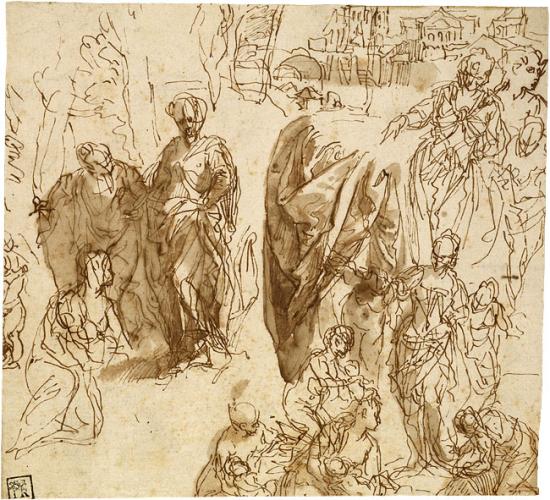
Studies for The Finding of Moses, ca. 1580
Purchased by Pierpont Morgan, 1909
In this lively sheet of studies for the Finding of Moses, circa 1580 (Prado, Madrid), the artist worked in rapid strokes of pen and brown ink to resolve problems not only of pose but of light and volume. The subject derives from the Old Testament account in which Moses was hidden by his mother in the bulrushes to escape Pharoah's order that all male Israelite infants be killed; he was later found and cared for by Pharoah's daughter.
Unlike Titian and Tintoretto—the other members of the triumvirate of extraordinary artists active in Venice during the second half of the sixteenth century—Veronese most commonly drew rough sketches with a fine pen, thin wash, and a light touch, combining several ideas for groups of figures on a single sheet.
The present drawing documents the artist's various ideas for his composition of the Finding of Moses, which he painted in several versions, all thought to date from the 1580s.
Innovations in Drawing
Technical and artistic innovations combined to make Renaissance Venice a vital creative center. Late-fifteenth-century artists generally worked in pen and ink and wash to make relatively finished drawings, but new techniques emerged that enabled them to produce more diverse, and often dramatic, effects. Artists such as Vittore Carpaccio perfected a method of applying ink with a brush onto Venetian blue paper (carta azzurra)—a support greatly prized by Albrecht Dürer. Artists of Titian and Bordone's generation, followed by Tintoretto, preferred a soft black chalk that was ideally suited to record tonal subtleties and create impressions of movement. Jacopo Bassano's innovative use of colored chalks made him a precursor to the pastel tradition. Tintoretto's younger contemporary, Veronese, developed entire compositions with rapid pen sketches while retaining a typically Venetian preoccupation with light.
